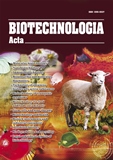ISSN 2410-7751 (Print)
ISSN 2410-776X (Online)

Biotechnologia Acta Т. 17, No. 1 , 2024
P. 20-28, Bibliography 16, Engl.
UDC:: 608:576
DOI: https;//doi.org/10.15407/biotech17.01.020
Full text: (PDF, in English)
DIRECTIONS OF DEVELOPING NEW TECHNOLOGIES BASED ON CULTIVATION OF ANIMAL CELLS AND TISSUES
T.M. Lutsenko, A. S. Chernetsky, P.S. Kovalchuk, A.V. Prozor, O.O. Krailo, B.A. Ruzhytska
National Technical University of Ukraine
“Igor Sikorsky Kyiv Polytechnic Institute”
Animal cell cultures found applications in various fields, from essential to advanced research. This includes studying the fundamentals of cell biology, mechanisms of the cell cycle, specialized cell functions, cell-cell and cell-matrix interactions, toxicity testing for the new drugs styling, and gene therapy for replacing non-functional genes with functional cells, characterization of cancer cells, understanding the role of various chemical substances, viruses, and radiation in cancer cells, vaccine production, monoclonal antibodies, and pharmaceuticals. Additionally, cultivating viruses for use in vaccine production, such as for diseases like rabies, hepatitis B, and measles, is another important application of animal cell cultures.
Aim. This study purposed to analyze the literature data on the use of animal cell lines in genetic engineering, therapy, xenotransplantation, biopharmaceuticals, the food industry, and research.
Methods. The analytical literature data review was conducted using the information analysis of the Medline (PubMed), Web of Science, and Scopus databases, Google Scholar, the Cochrane Central Register of Controlled Trials (CENTRAL), and other sources up to the inclusive year 2023 using the keywords: “animal cell lines”, “immunobiological preparations”, “xenotransplantation”, “biopharmaceuticals”, “genetic engineering”.
Results. The research analysis related to the animal cells used in the biopharmaceutical industry was carried out, and considerations regarding the prospects for their use in various research and production technologies were outlined.
Conclusion. The technology of cultivating animal cells became a fundamental tool in developing research in biotechnological sciences. The ability to culture animal cells in vitro allowed the development of innovative methods, such as iPSC and organ-on-a-chip models, which provided valuable information about the disease mechanisms and potential therapeutic targets. Although there are some challenges with the use of animal cells related to variability in differentiation efficiency and concerns about safety and efficacy, further studies are needed to optimize protocols and overcome these limitations. Animal cell culture technology remains essential to modern biomedical research and can potentially revolutionize regenerative medicine..
Key words: animal cell lines, immunobiological preparations, xenotransplantation, biopharmaceuticals, genetic engineering.
References
- Chandra, V., Tiwari, A., Pant, K.K., Bhatt, R. (2022). Animal Cell Culture: Basics and Applications. In: Verma, P. (eds) Industrial Microbiology and Biotechnology. Springer, Singapore. https://doi.org/10.1007/978-981-16-5214-1_24
- 2. Richter M, Piwocka O, Musielak M, Piotrowski I, Suchorska WM, Trzeciak T. From Donor to the Lab: A Fascinating Journey of Primary Cell Lines. Front Cell Dev Biol. 2021, V.9:711381. https://doi.org/10.5772/66905
- Yunus Celik, Kadir Alptekin, S. Furkan Demirden, Suphi S. Oncel, A novel low shear horizontal bioreactor design for the production of animal cells: Effect of bioreactor dynamics on the 3D spheroid formation of HepG2, Biochemical Engineering Journal. 2023, V.196:108952. https://doi.org/10.1016/j.bej.2023.108952
- Verma A, Verma M, Singh A. Animal tissue culture principles and applications. Animal Biotechnology. 2020, P.269‒293. https://doi.org/10.1016/B978-0-12-811710-1.00012-4
- Brucato A., Busciglio A., Scargiali F. Unbaffled, Stirred Bioreactors for Animal Cell Cultivation. Current Developments in Biotechnology and Bioengineering. 2017. P. 97–142. https://doi.org/10.1016/b978-0-444-63663-8.00005-7
- Argang Kazemzadeh, Cynthia Elias, Melih Tamer, Ali Lohi, Farhad Ein-Mozaffari, Mass transfer in a single-use angled-shaft aerated stirred bioreactor applicable for animal cell culture. Chemical Engineering Science. 2020, V.219:115606. https://doi.org/10.1016/j.ces.2020.115606
- Dumont J, Euwart D, Mei B, Estes S, Kshirsagar R. Human cell lines for biopharmaceutical manufacturing: history, status, and future perspectives. Crit Rev Biotechnol. 2016, 36(6):1110‒1122: https://doi.org/10.3109/07388551.2015.1084266
- Kuystermans D., Al-Rubeai M. Biopharmaceutical Products from Animal Cell Culture. Cell Engineering. Cham, 2014, P.717–757. https://doi.org/10.1007/978-3-319-10320-4_23
- Mitra S., Tomar P. C. Hybridoma technology; advancements, clinical significance, and future aspects. Journal of Genetic Engineering and Biotechnology. 2021, V.19:1. https://doi.org/10.1186/s43141-021-00264-6
- Bayer V. An Overview of Monoclonal Antibodies. Seminars in Oncology Nursing. 2019, V.35:150927. https://doi.org/10.1016/j.soncn.2019.08.006
- Maoz B. M. Brain-on-a-Chip: Characterizing the next generation of advanced in vitro platforms for modeling the central nervous system. APL Bioengineering. 2021, V.5:030902. https://doi.org/10.1063/5.0055812
12. Bang S., Jeong S., Choi N., Kim H. N. Brain-on-a-chip: A history of development and future perspective. Biomicrofluidics. 2019, 13(5):051301. https://doi.org/10.1063/1.5120555
- 13. Mofazzal Jahromi, M. A., Abdoli, A., Rahmanian, M., Bardania, H., Bayandori, M., Moosavi Basri, S. M., Kalbasi, A., Aref, A. R., Karimi, M., & Hamblin, M. R. Microfluidic Brain-on-a-Chip: Perspectives for Mimicking Neural System Disorders. Molecular neurobiology, 2019, 56(12):8489–8512. https://doi.org/10.1007/s12035-019-01653-2
- 14. Franzen N, van Harten WH, Retèl VP, Loskill P, van den Eijnden-van Raaij J, IJzerman M. Impact of organ-on-a-chip technology on pharmaceutical R&D costs. Drug Discov Today. 2019, 24(9):1720‒1724. https://doi.org/10.1016/j.drudis.2019.06.003
- 15. Ofenbauer A., Tursun B. Strategies for in vivo Current Opinion in Cell Biology. 2019, V.61:9–15. https://doi.org/10.1016/j.ceb.2019.06.002
- 16. Mei Y, Wang Y, Chen H, Sun ZS, Ju XD. Recent Progress in CRISPR/Cas9 Technology. J Genet Genomics. 2016, 43(2):63‒75. https://doi.org/10.1016/j.jgg.2016.01.001
- Horie M, Yamano-Adachi N, Kawabe Y, Kaneoka H, Fujita H, Nagamori E, Iwai R, Sato Y, Kanie K, Ohta S, Somiya M, Ino K. Recent advances in animal cell technologies for industrial and medical applications. J. Biosci. Bioeng. 2022, 133(6):509‒514. https://doi.org/10.1016/j.jbiosc.2022.03.005
© Palladin Institute of Biochemistry of National Academy of Sciences of Ukraine, 2024

